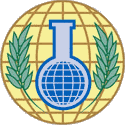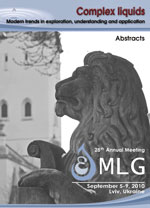Effect of Methanol on Microphase Separation of Ionic Liquids
Toshiyuki Takamuku
The previous molecular dynamics (MD) simulations on 1-alkyl-3-methylimidazolium (Cnmim+)-based ionic liquids have shown that microphase separation occurs in the ionic liquids [1,2]. Thus, the positively charged imidazolium ring and anion form polar domains in pure ionic liquids, while the alkyl chains of the imidazolium cations aggregate to form nonpolar domains. The other MD simulations on Cnmim+NO3- -water systems have revealed that microphase separation of the ionic liquids is loosened by addition of water [3]. The polar domains are gradually disrupted by intruding water aggregate formed around NO3-. The repulsive force acts between Cnmim+. This leads to the weakening of the interaction among the alkyl chains in the nonpolar domains. However, effects of a molecular liquid on microphase separation of imidazolium-based ionic liquids have not been corroborated by experimental results.
In the present investigation, we have made small-angle neutron scattering (SANS) measurements on methanol solutions of Cnmim+ bis-(trifluoromethanesulfonyl)amide (TFSA-) with varying the alkyl chain length from n = 4 to 12 to observe the heterogeneous mixing of the Cnmim+TFSA- -CD3OD solutions. In addition, the interactions of methanol-methanol, Cnmim+ -methanol, and TFSA- -methanol have been evaluated by means of attenuated total reflectance infrared (ATR-IR) spectroscopy and 1H and 13C NMR.
The SANS measurements revealed that the heterogeneity of the Cnmim+TFSA- -methanol solutions, except for C4mim+TFSA-, is most enhanced at methanol mole fraction of xCD3OD = 0.97 over the entire range. Thus, the mole fraction of the maximum heterogeneity of the solutions is independent of the alkyl-chain length. In contrast, the magnitude of the maximum heterogeneity of the solutions is larger in the order of the alkyl-chain length from n = 4 to 12. ATR-IR and NMR measurements showed that the hydrogen bonds among methanol molecules are conspicuously evolved in the solutions above xCH3OH = 0.8. The increase in the concentration of the hydrogen-bonded methanol with increasing xCH3OH does not significantly depend on the alkyl-chain length. On the basis of these results, the loosening of the polar and nonpolar domains in the ionic liquids with increasing methanol content will be discussed at the molecular level.
References
- J. N. C. Lopes, M. F. C. Gomes and A. A. H. Padua, J. Phys. Chem. B 2006, 110, 16816.
- A. A. H. Padua, M. F. C. Gomes and J. N. A. C. Lopes, Acc. Chem. Res. 2007, 40, 1087.
- W. Jiang, Y. Wang and G. A. Voth, J. Phys. Chem. B 2007, 111, 4812.



